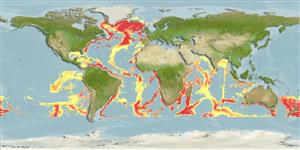Teleostei (teleosts) >
Aulopiformes (Grinners) >
Bathysauridae (Deepsea lizardfishes)
Etymology: Bathysaurus: Greek, bathys = deep + Greek, sauros = lizard (Ref. 45335).
More on author: Günther.
Environment: milieu / climate zone / depth range / distribution range
Ecology
Marine; bathydemersal; depth range 600 - 3500 m (Ref. 4472), usually 1000 - 2500 m (Ref. 5951). Deep-water; 70°N - 50°S, 180°W - 180°E
Eastern Atlantic: northern British Isles to Guinea; also off South Africa. Reported from Iceland (Ref. 12462). Western Atlantic: Davis Strait to Rio Grande Rise, Brazil. Southwest Pacific: New Zealand and Australia (Ref. 7300). Southeast Pacific: Nazca and Sala-y-Gomez (Ref. 50546). Macristium chavesi (pelagic larvae) known from Dominican Republic, Bay of Biscay, Azores, and in the Indian Ocean.
Size / Weight / Age
Maturity: Lm ? range ? - ? cm
Max length : 64.0 cm SL male/unsexed; (Ref. 4472)
Usually occurs below the 4°C isotherm. Rests stationary on the bottom with head slightly elevated in typical lizardfish fashion. Feeds primarily on fish and decapods (Ref. 4964). Synchronously hermaphroditic. Minimum depth reported from Ref. 5755.
Life cycle and mating behavior
Maturity | Reproduction | Spawning | Eggs | Fecundity | Larvae
Also Ref. 103751.
Sulak, K.J., 1990. Synodontidae. p. 365-370. In J.C. Quero, J.C. Hureau, C. Karrer, A. Post and L. Saldanha (eds.) Check-list of the fishes of the eastern tropical Atlantic (CLOFETA). JNICT, Lisbon; SEI, Paris; and UNESCO, Paris. Vol. 1. (Ref. 4472)
IUCN Red List Status (Ref. 130435: Version 2024-2)
Threat to humans
Harmless
Human uses
Fisheries: commercial
Tools
Special reports
Download XML
Internet sources
Estimates based on models
Preferred temperature (Ref.
123201): 2 - 5.4, mean 3.3 °C (based on 4492 cells).
Phylogenetic diversity index (Ref.
82804): PD
50 = 1.0000 [Uniqueness, from 0.5 = low to 2.0 = high].
Bayesian length-weight: a=0.00324 (0.00127 - 0.00824), b=3.16 (2.94 - 3.38), in cm total length, based on LWR estimates for this (Sub)family-body shape (Ref.
93245).
Trophic level (Ref.
69278): 4.3 ±0.69 se; based on food items.
Fishing Vulnerability (Ref.
59153): Moderate to high vulnerability (51 of 100).
Nutrients (Ref.
124155): Calcium = 27 [12, 76] mg/100g; Iron = 0.478 [0.175, 1.036] mg/100g; Protein = 15.1 [12.1, 17.4] %; Omega3 = 0.241 [0.074, 0.627] g/100g; Selenium = 27 [9, 65] μg/100g; VitaminA = 13.3 [2.4, 63.5] μg/100g; Zinc = 0.329 [0.202, 0.522] mg/100g (wet weight);
